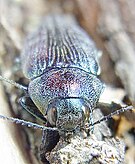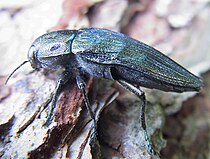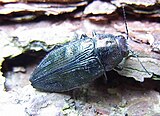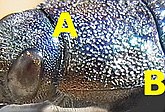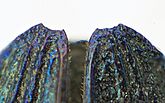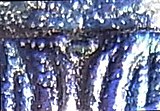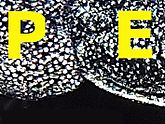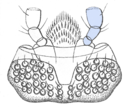Peasant jewel beetle
| Peasant jewel beetle | ||||||||||||
|---|---|---|---|---|---|---|---|---|---|---|---|---|

Peasant jewel beetle |
||||||||||||
| Systematics | ||||||||||||
|
||||||||||||
| Scientific name | ||||||||||||
| Buprestis rustica | ||||||||||||
| Linnaeus , 1758 |
The peasant jewel beetle ( Buprestis rustica ) is a beetle from the jewel beetle family . The genus Buprestis is represented in Europe with three subgenera and 14 species. The species Buprestis rustica belongs to the subgenus Buprestis and occurs in Europe in the subspecies Buprestis rustica rustica . Buprestis rustica is easily confused with Buprestis haemorrhoidalis .
The beetle is not endangered in Baden-Württemberg, but is protected as a jewel beetle. In the red list of West Berlin and Saxony-Anhalt it is listed under category 0 (extinct or missing). The species is not explicitly listed in Germany's Red List, but according to the Federal Species Protection Ordinance, as a jewel beetle , it is one of the specially protected species.
Notes on the name
The beetle was already described by Linnaeus in 1758 in the famous 10th edition of his Systema Naturae under the scientific name Buprestis rustica , which it still bears today. Linné mentions an older description from 1746 in Fauna Svecica , in which, however, the binomial nomenclature is not yet used. The description from 1758 does not contain any, the one from 1746 only a vague reference to why Linnaeus might have given the beetle the species name rustica . Rusticus ( lat. ) Means rural or living in the country (lat. Rús ) . The beetle's habitat is in the montane to subalpine region. In the fauna of Svecica one finds the comment habitat in sylvis ad aquas (lat. Lives in forests by water , i.e. on the land) for the beetle . The German name Bauern-Prachtkäfer is a translation of the scientific name into German. In the literature one can also find the German names Ländlicher Prachtkäfer or Bauer for short .
The genus Buprestis was established by Linnaeus when the binomial nomenclature was introduced. The name altgr. Βούπρηστις Bōūprestis was used in ancient times and the Middle Ages, but for another insect that was also used in medicine.
Linguistically, the name Buprēstis is derived from ancient Gr . βούς, bōūs, beef, and πρήθω, prētho, “I puff up”. It was originally used for an insect that caused cattle to swell and possibly die if accidentally swallowed.
Since the beetle varies greatly in color and drawing, it has been described several times as new or as a variety, or the name commonly used in the local language has been Latinized. Thus arose the synonyms Buprestis lata Sulzer (lat., 1776 lata for broad , German name , the width ), Buprestis signaticeps Fleischer , 1887 (signāticeps of lat. Signatus , drawn and compositions -ceps of celtic kep for head because he only am Head has yellow spots), Buprestis bisornata Fleischer 1887 (bisornātus from Latin bi or bis , twofold and ornatus , decorated because it has yellow spots on two parts of the body), Buprestis bimaculata Kraatz , 1880 (Latin bimaculata for with two spots ), Buprestis obscura Schilsky , 1888 (Latin obscura for dark ) or Buprestis violacea De Geer , 1774 (Latin violacea for violet ).
In the literature, the beetle often appears under the synonym Ancylochira rustica or Ancylocheira rustica . The genus name Ancylochira goes back to Eschscholtz , who divided the large genus Buprestis into more than a dozen genera according to a key. In the description of the genus by Eschscholtz, one finds the sentence tibiis anticis maris unco reflexo (Latin on the front rails of the male with a hook bent backwards ). This explains the generic name Ancyloch (e) ira from Old Gr. αγκύλος “ankýlos” for “curved, curved” and χείρ “chēīr” for “hand”, in this case for “front rail” and names the spurred forefoot (Fig. 13 above).
Characteristics of the beetle
The beetle becomes twelve to twenty millimeters long. It has an approximately boat-shaped outline that is more rounded at the head and ends more pointedly with the wing-coverts. However, the closed neck shield is not nearly a straight line to the elytra to as Buprestis haemorrhoidalis , but throat plate (in Fig. 9 left pronotum P) and elytra (in Fig. 9, right Elytren E) gape at the sides apart and form an angle of about 60 Degree to each other. The kind belongs to the flatter kinds of the kind. The color varies a lot. The animals are usually dark green to blue-green on top, but you can also find lighter green, light ore-colored, copper-colored, purple, steel-blue to black specimens. In addition, they can shimmer purple in places (for example in the taxo picture near the edge of the wing covers in the rear area). The color partly depends on the angle of incidence of the lighting. The underside of the body is lighter, shiny copper or greenish. Yellow spots on the underside and in the front of the head are usually only found in males. If yellow spots appear on the chest or on the anal sternite , then they are small, while in Buprestis haemorrhoidalis they are larger.
The head is inclined downwards at an angle to the body axis. It is dense wrinkled punctured . The forehead is indistinctly furrowed lengthways. The eyes are large and slightly arched. They don't touch the base of the mandibles. The eleven-segment antennae are positioned far apart in front of the eyes in small and imperforate antennae sockets. They are dark metallic. They hardly differ in males and females. They are thin and from the third link onwards they are weakly sawn inward. The upper lip is roughly square and slightly cut out in front (in Fig. 6, right half green). The male's upper jaws, which are spotted yellow (in Fig. 6, tinted blue on the right) are strong, only slightly curved and bidentate. The structure and shape of the lower jaw with the jaw probe (in Fig. 6, right red) can be seen in Fig. 10. The last jaw probe link is not ax-shaped, but hardly expanded at the end and about the same size as the third link in front of it. The lower lip and lip switch are shown in Figure 11. The lip switch end link is egg-shaped and truncated.
The pronotum is broadest and strongly punctured just before the base. It is a good twice as wide as it is long and flattened on the sides. The forward narrowing is more rounded than in Buprestis haemorrhoidalis . The sharp side edge of the pronotum (marked with B in Fig. 5) extends to the front edge (marked with A in Fig. 5) and forms a more or less clear angle with it. The pronotum is coarse and dense in the middle, with wrinkled dots on the edge. The front edge is weak, the base clearly two-indented. On each side the pronotum is more or less clearly indented on the rear half. The rear corners are directed a little backwards and sharply right-angled.
The label is quite small and round to cross-oval (Fig. 8).
The elytra are gradually pointed behind the middle. They are not evenly curved, but have transverse impressions. They are striped with dots. The stripes are cut deeper than in Buprestis haemorrhoidalis . The dots in the stripes are deep, the spaces flattened at the top are each provided with an irregular row of flatter dots. The dots are sparse and fine, especially towards the middle of the elytra, and the dots are wrinkled at the edge of the elytra. The tip is truncated more obliquely inwards than in Buprestis haemorrhoidalis . Both types have usually little noticeable teeth at the outer corner and at the suture corner (Fig. 7, atypical in Fig. 3 top right wing cover end).
The underside is more dense in front, less densely dotted and gray haired towards the rear (Fig. 4 and Fig. 2 above). The Prosternum is extended backwards between the front hips (Prosternal Process). The prosternal process ends in a depression in the metasternum, which is continued in a longitudinal suture. However, there is no mechanism designed to jump up like the click beetles. Eight tergites are visible under the wing covers . In the male, the last sternite ends in a slightly concave truncated manner and has a small yellow spot on each side (left in Fig. 12, the normally concealed genital organs are everted here); in the female the last abdominal sternite is slightly double-indented at the back and without a spot (right in Fig. 12, only visible when fully enlarged).
The rear hips are expanded inward. The tarsi are all five-part. The hind tarsi are relatively narrow, the first limb is longer than the second. The claws are not split or toothed, but simple. In the male, the fore legs are thickened, the rails are slightly curved and armed on the inside with a sharp tooth pointing backwards (Fig. 13). This makes it easier for him to grip the female during mating.
biology
The beetles fly on the host plants in the hot midday hours in late summer. The peak of the flight time in Central Europe is in August, which is why the beetle is classified as a late summer species. The beetle is found in Central Europe from June to September. In Finland, when an investigation was carried out, catches ranged from June 26 to mid-August.
The species develops in conifers, mainly spruce , fir and pine , more rarely larch . Felled or dying stems and stems are used to lay eggs. The presence or absence of bark is insignificant, even trees that are charred on the surface do not prevent the beetle from laying eggs and do not hinder the development of the larvae. The larval ducts do not run in the bark , but in the bast layers underneath or in the sapwood . A development time of two years is assumed. The adults gnaw needles. Both the feeding activity of the adults and the drilling activity of the larvae are usually insignificant for forestry . In the literature, only the damage to untreated railway sleepers on the island of Öland is known.
Hazard and protection
The beetle is not uncommon in places, on the other hand, current evidence is lacking at many former sites. For protection, it is recommended not to remove old and dead wood in middle and higher altitudes, but rather to cultivate extensive areas close to nature or not at all.
distribution
The peasant jewel beetle is a Euro-Siberian species. In Europe it occurs from montane to subalpine from Scandinavia to southern Europe , but is absent on the Mediterranean islands, in Portugal and the Benelux countries as well as in some city-states. However, it is generally rare.
literature
- Heinz Joy, Karl Wilhelm Harde, Gustav Adolf Lohse: The beetles of Central Europe . tape 6 : Diversicornia . Spectrum, Heidelberg 1979, ISBN 3-87263-027-X . P. 218
- Klaus Koch : The Beetles of Central Europe Ecology . 1st edition. tape 2 . Goecke & Evers, Krefeld 1989, ISBN 3-87263-040-7 . P. 93
- Fritz Brechtel, Hans Kostenbader (ed.): The splendor and stag beetles of Baden-Württemberg . Ulmer, Stuttgart (Hohenheim) 2002, ISBN 3-8001-3526-4 . P. 422ff
- Edmund Reitter : Fauna Germanica, the beetles of the German Empire III. Volume, KGLutz 'Verlag, Stuttgart 1911, p. 185
- Gustav Jäger (Ed.): CG Calwer’s Käferbuch . K. Thienemanns, Stuttgart 1876, 3rd edition p. 331 as Ancylochira rustica
Individual evidence
- ↑ Buprestis (subgenus) in Fauna Europaea. Retrieved November 14, 2015 , Cypriacis (subgenus) from Fauna Europaea. Retrieved November 14, 2015 and Pseudyamina (subgenus) from Fauna Europaea. Retrieved November 14, 2015
- ↑ a b Buprestis rustica at Fauna Europaea. Retrieved November 14, 2015
- ↑ Red List Saxony-Anhalt
- ^ Carolus Linnaeus: Systema Naturae .... 1st volume, 10th edition, Stockholm 1758 p. 413: 409 No. 8 rustica
- ^ A b Carolus Linnaeus: Fauna Svecica .... Stockholm 1746 p. 180 no. 555
- ↑ a b c d Sigmund Schenkling: Explanation of the scientific beetle names (species)
- ↑ Joh. Matth. Bechstein, Georg Ludwig Scharfenberg: Complete natural history of the harmful forest insects 1. Part Leipzig 1804 Rural jewel beetle
- ↑ a b Sigmund Schenkling: Explanation of the scientific beetle names (genus)
- ↑ a b Johann Heinrich Sulzer: Abbreviated history of insects, first part, Winterthur 1976 title page Explanation of the name Buprestis in great detail
- ^ A b c Anton Fleischer: "About Buprestis rustica L. and haemorrhoidalis Hbst." In Wiener Entomologische Zeitung 6th year, Vienna 1887 p. 233
- ↑ G. Kraaz: About varieties of the German Buprestis (Ancylochira) species in Entomological monthly sheets, second year Berlin 1880. P. 134
- ↑ J. Schilsky: Systematic Directory of Beetles in Germany, Berlin 1888. P. 73
- ^ Carl De Geer: Mémoires pour servir à l'histoire des insectes Tome quatrième (4th volume) Stockholm 1774 P. 71 9. Art preview in the Google book search Buprestis violacea
- ↑ Friedrich Eschscholtz: Zoological Atlas 1. Issue Berlin 1829 P. 9 in the Google book search
- ↑ a b Edmund Reitter : Fauna Germanica Volume III Plate 118 Fig. 15b, 15c
- ^ WF Erichson et al .: Natural history of the insects of Germany Coleoptera fourth volume Berlin 1857 p.51 as Ancylochira rustica
- ↑ M. Olivier: Entomologie ou Histoire Naturelle des Insectes Coleoptères Tome II Paris 1790 as the 90th species of the 32nd genus Bupreste rustique
- ↑ Uunio Saalas: The Spruce Beetles Finland 2. Volume Helsinki 1923 Description
- ↑ T. Palm: Wood-destroying insects in railway sleepers in the state forest Böda (Öland) in Entomologisk Tidskrift volumes 77–79, 1957 p. 163 (volume 77 1956 p. 40–48)
- ↑ Distribution map of Fauna Europaea ( memento of the original from November 24, 2015 in the Internet Archive ) Info: The archive link was inserted automatically and has not yet been checked. Please check the original and archive link according to the instructions and then remove this notice.


